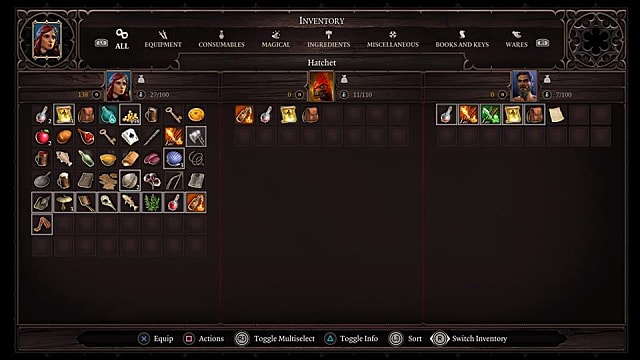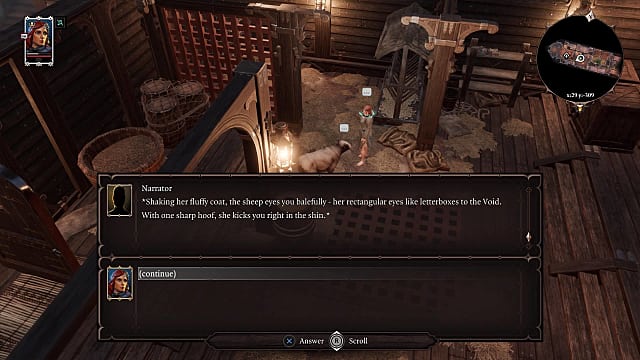

One of the best RPGs of 2017 is about to get even better with the launch of its Definitive Edition. Available as a free upgrade for existing PC players, the bigger news is that this modern-day CRPG classic is now up for grabs for the console crowd as well.
Yes, we're talking about the criminally good Divinity: Original Sin 2, which originally released last September and some of the best gameplay of any CRPG all year.
Making the leap from computer to PS4 and Xbox One meant there were going to be some big changes, and those are what we're going to focus on here rather than re-reviewing the core gameplay and story.
If you haven't played the original version and want to know what's in store, you can read our full review here.
Square Peg In A Round Hole
First thing's first -- the Definitive Edition is still a glorious turn-based, tactical role-playing experience. It remains absurdly fun; turning enemies into chickens and teleporting enemies into broken-oil-barrel infernos is still a blast.
Much of the game's base experience remains the same (with some welcome tweaks noted below). The main differences you will notice immediately come in the form of UI and control scheme changes specifically made for the console edition.
I'm not going to sugar coat it -- this is a game that's meant to be played with a keyboard and mouse. Can you imagine trying to play Baldur's Gate or Icewind Dale on a controller? If you've ever tried, you know it can be dicey at best.
Here's the thing, though. Larian Studios made a truly valiant effort to get this game working without a mouse. It is beyond clear that a ton of thought went into transferring the core D:OS2 gameplay mechanics into an intuitive experience for a PS4 or Xbox One controller.
Sadly, it ultimately falls short, and after having spent a good deal of time with the Definitive Edition, I can easily say I still prefer the keyboard and mouse.
The main menus are opened in a radial wheel in the vein of Dragon Age, with an inventory screen more along the lines of Oblivion. If you've played the PC version, you know that every area is littered with objects, from barrels to candles to flowers, that can all be opened, picked up, moved, lit on fire, etc.
While it works great in the PC version, all of that exploration doesn't work particularly well with a controller, and using the bumper keys to switch between very-close objects still isn't quite fine tuned enough to always hit what you want.
The developers obviously knew that would be an issue, so now you can initiate a search area in a specific radius around any character. Everything within that area that can be opened or picked up appears in list form, and you can easily move between each individual object.
My first thought was to wildly abuse this feature to get into objects I wasn't supposed to be able to reach. Sadly, the devs figured that out, too, and you still have to be able to reach an object in the search area to open it and begin looting (curses!).
On the other side of that coin, there are some advantages to this change. To properly sneak through areas or get single characters positioned for combat advantage, you've got to frequently break up your party. Switching between characters and chain-linking groups (or breaking them up) was easier than I expected with the controller.
In that regard, the radial menu actually works pretty well. Inventory and equipment management isn't as smooth as on PC, but party management isn't half bad. Overall, the radial menu is my one big complaint with the Definitive Edition, but it's one that some players may not find as intrusive as I did.
Arena Mode
Now that we've got that unpleasantness out of the way, let's dive into a very welcome change -- Divinity's revamped arena mode!
On my first playthrough of the original PC version, I distinctly remember stumbling across the Arena Of The One beneath Fort Joy and thinking, "I need a full-game version of this." Well, we've got it now, and it is absolutely nuts.
You can play the arena against friends or A.I., and there are several different map layouts to choose from. The replay value here is huge if you love the tactical combat of Divinity: Original Sin 2 but don't want to replay the story mode again. Getting to play with fully upgraded characters that have all sorts of skills right off the bat is a ton of fun, and there is an absurd number of options available.
Having a full 16 heroes to choose from is just the beginning of the changes. Mutators are the major new element here -- and they increase the fun quotient about 10,000%. These wacky options change the flow of battle every turn (they can, alternatively, remain static if you want). Everyone on the battlefield might suddenly get functional wings to fly over terrain or all the barrels might automatically explode. The options are seemingly endless.
If you thought battlefields could becoming crazy flaming, electrified, frozen hellscapes of tactical nonsense in the original version, you haven't seen anything yet.
Other Changes From The Base Game
The Definitive Edition kicks off with a brand-new tutorial area in the ship bound for Fort Joy, and that will be very welcome to console players who didn't already master the ins and outs of this complex system on PC.
Tutorials aside, the newly added story mode also widens the appeal of this otherwise hardcore game. Many battles -- even some very early ones -- can be overwhelming for new players not familiar with the mechanics. Even on normal difficulty, it is entirely possible to die in the very first fight with the viscous voidwoken, and beyond easy to get annihilated when trying to escape Fort Joy.
If you find the combat incomprehensible, pop on story mode and just enjoy experiencing the ride.
But what about changes for returning players who don't want the game to be easier? There are changes for you in the form of tweaks and additions to late-game content, so if you weren't satisfied with the ending, give it another go. Arx, in particular, was a major sticking point for a lot of players. The quality of that area just fell short of the earlier acts, both in the writing and in the area design. It was easy to get lost or have no clue where to find people to advance storylines.
Much of that has been retooled with the Definitive Edition, and with changes to the quest log, there's less frustration in this area. A lot of work went into changing this area, including entirely new dialog.
Finally, the dwarf battlemage Beast had some big upgrades on his origin quest as well, so if you never cared for bringing him along, he's worth exploring with now as well.
The Bottom Line
If you've already played Divinity: Original Sin 2, the late-game content changes make the Definitive Edition worth a re-install.
Watching companies like Larian develop games through crowdfunding and then give players what they want is a breath of fresh air in the gaming community. The changes made were all clearly culled from fan criticism over the past year, and overall, they make the game a better experience.
For PC players, this is easily a 9/10 game (or potentially even higher if you absolutely love turn-based tactical combat). On the console front however, the control scheme is wonky enough to knock the game's rating down a bit.
It's still fun, no doubt, and you are getting an improved version of an already great game. The gameplay here is still great. Sadly, after playing the PS4 version, though, I really just want to re-install the game through Steam and play with the Definitive Edition changes over there.
You can buy the console version of Divinity: Original Sin 2 Definitive Edition on Amazon for $59.99.
Related Content:
- Complete Crafting Recipes Guide
- Skill Crafting Combos and Book Vendors
- Character Creation Guide
- Ultimate Build Guide
- More Divinity 2 Guides
[Note: The developer provided the copy of Divinity: Original Sin 2 Definitive Edition used in this review.]




0 comments:
Post a Comment